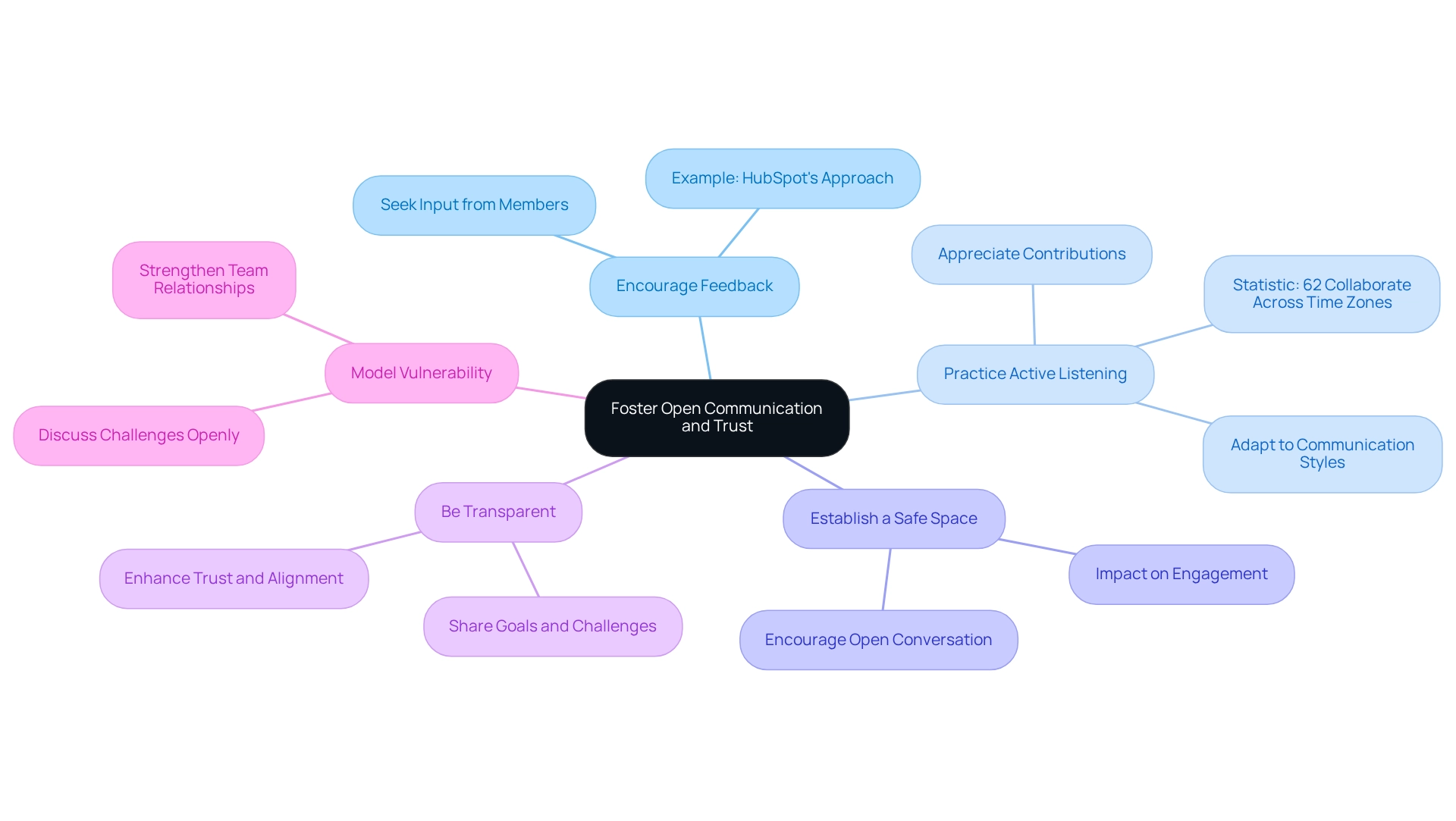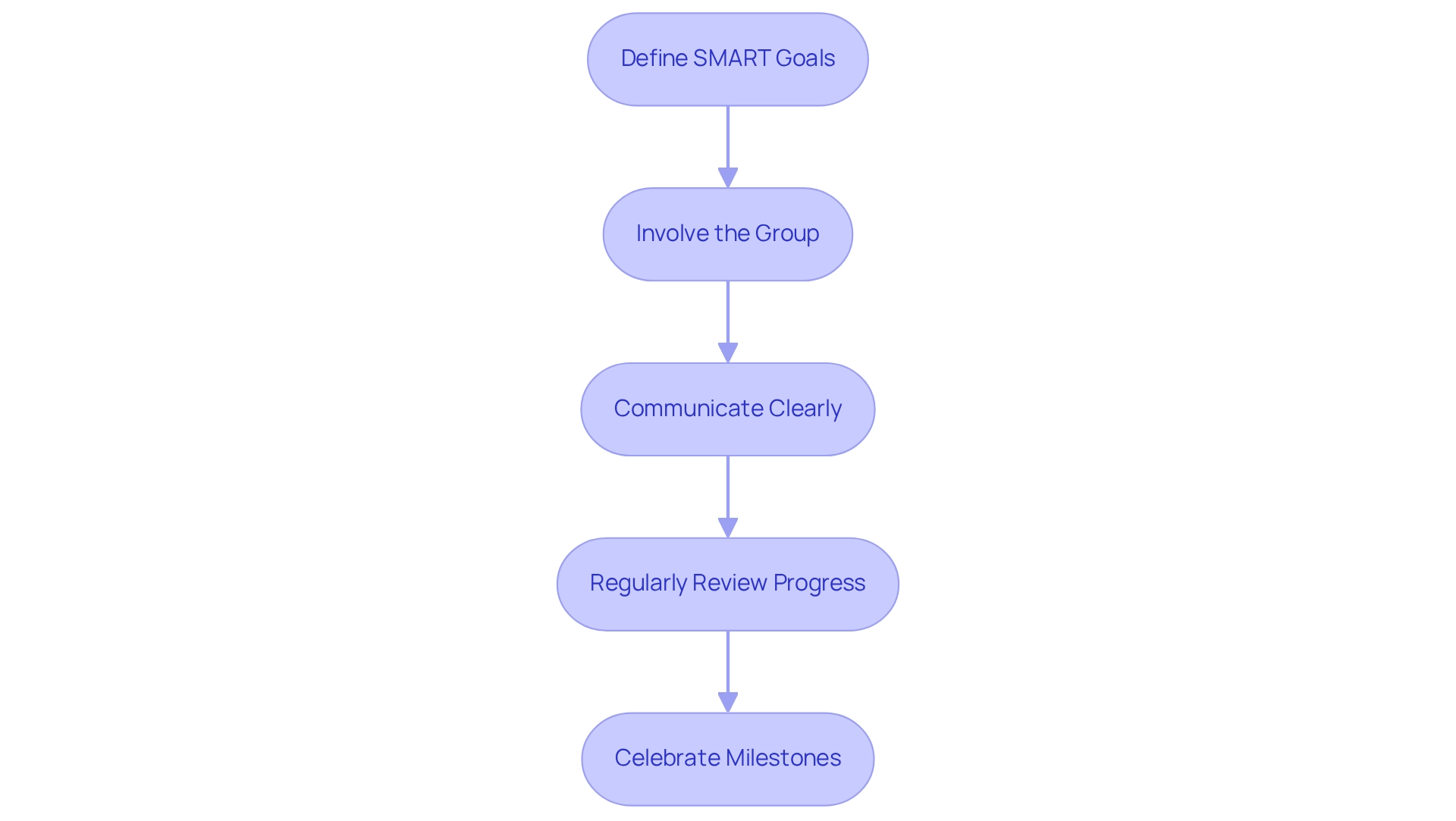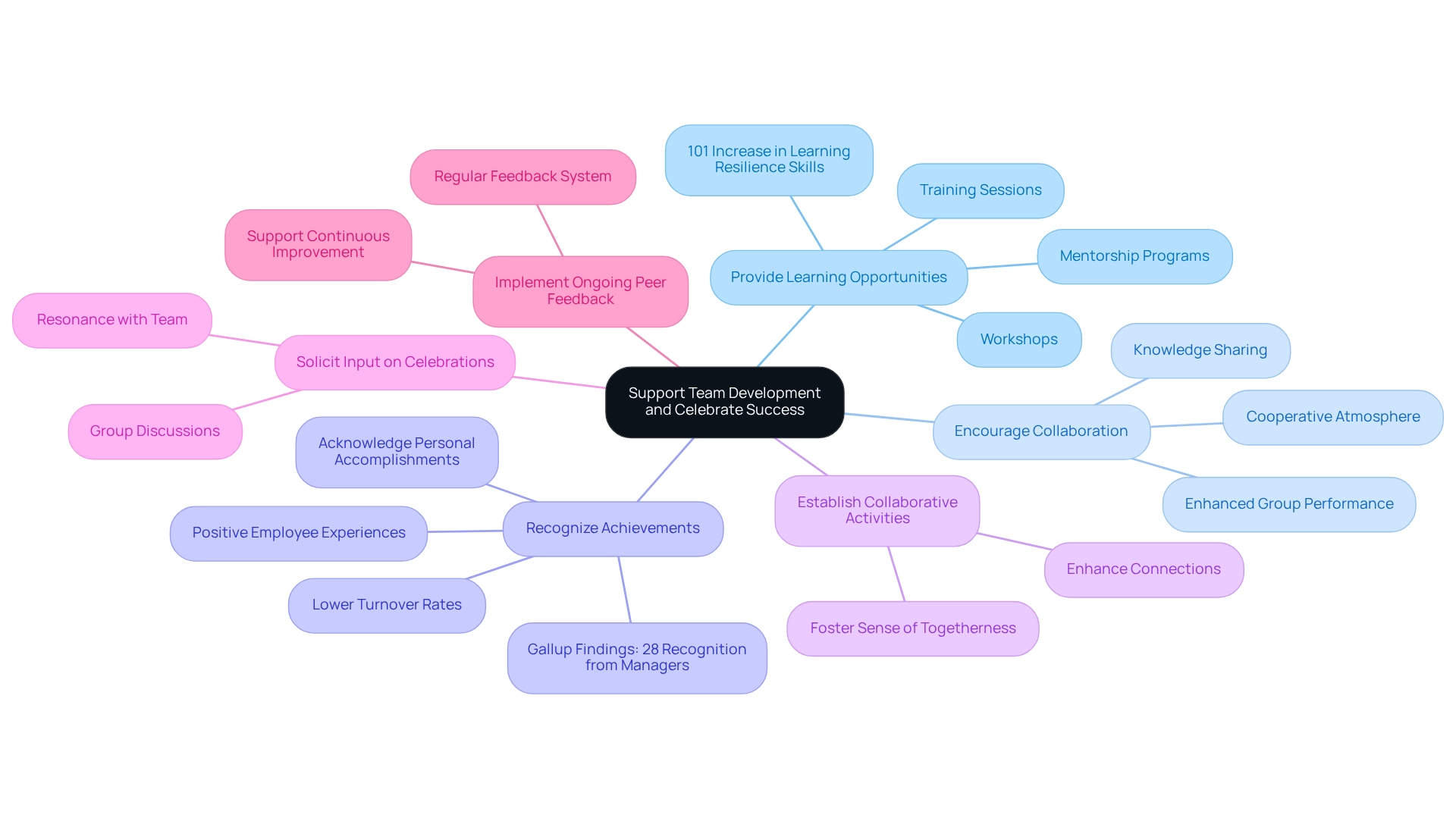Overview
To excel as a team leader, one must embody essential qualities such as:
- Integrity
- Empathy
- Decisiveness
- Communication skills
- Adaptability
- Vision
These attributes are not merely desirable; they are crucial in fostering trust and motivating teams. This article elucidates how these traits enhance interpersonal relationships, promote clarity in objectives, and cultivate a collaborative environment. The result? Improved team performance and heightened engagement.
Key Highlights:
- Effective team leaders in 2025 should embody integrity, empathy, decisiveness, communication skills, adaptability, and vision.
- Integrity fosters trust, creating a safe environment for team members.
- Empathy helps leaders understand colleagues’ perspectives, enhancing relationships.
- Decisiveness allows leaders to make informed decisions promptly in complex situations.
- Clear communication is vital for articulating goals and aligning team efforts.
- Adaptability enables leaders to guide teams through changing circumstances.
- A strong vision motivates teams and aligns their efforts with organizational goals.
- Encouraging feedback from team members reinforces their value and enhances group dynamics.
- Active listening fosters a sense of belonging and appreciation among team members.
- Establishing a safe space for open expression encourages collaboration and innovation.
- Transparency in sharing goals and challenges builds trust and alignment within the team.
- Modeling vulnerability strengthens relationships and encourages open communication.
- Setting SMART goals enhances clarity and increases the likelihood of achieving objectives.
- Involving team members in goal-setting promotes ownership and commitment.
- Regular progress reviews reinforce accountability and allow for timely adjustments.
- Celebrating milestones boosts morale and sustains motivation within the group.
- Providing learning opportunities fosters continuous development and enhances skills.
- Recognizing achievements is crucial for boosting morale and employee engagement.
- Encouraging collaboration among team members leads to improved performance outcomes.
Introduction
In the rapidly evolving landscape of the workplace, effective leadership has never been more crucial. As teams navigate the complexities of 2025, leaders must embody a range of essential qualities that foster trust, communication, and adaptability. This article delves into the key attributes that define successful leaders:
- The importance of open communication and trust-building strategies
- The necessity of setting clear goals and expectations
- The significance of supporting team development
- Celebrating successes to cultivate a motivated workforce
By understanding and implementing these foundational principles, leaders can not only enhance their effectiveness but also drive their teams towards greater achievements in an increasingly competitive environment.
Identify Essential Leadership Qualities
To be an effective team leader in 2025, several essential qualities must be embodied:
- Integrity: Honesty and transparency are foundational for fostering trust among the group. Leaders who exhibit integrity foster an atmosphere where individuals feel safe and appreciated.
- Empathy: Grasping the viewpoints and emotions of colleagues is essential for cultivating strong relationships. Compassionate individuals are better prepared to tackle issues and inspire their groups.
- Decisiveness: Effective leaders make informed decisions promptly, guiding their groups with confidence. This decisiveness is vital in navigating the complexities of today’s work environment.
- Communication Skills: Clear and effective communication is essential for articulating goals and expectations. Leaders who communicate effectively can align their groups and enhance overall performance.
- Adaptability: The ability to adjust to changing circumstances is vital in a dynamic workplace. Leaders who embrace change can guide their groups through uncertainty and cultivate resilience.
- Vision: A strong individual should possess a clear outlook for the future and inspire others to work towards it. This vision not only motivates the team but also aligns their efforts with organizational goals.
Research indicates that employees under human-centered supervision are 37% more likely to be highly engaged, underscoring the importance of these qualities. As one expert observed, “Not every manager needs to be a guide, but effective leadership traits can greatly improve a manager’s efficiency.” Furthermore, organizations that prioritize leadership development are more likely to achieve financial success and maintain a competitive edge, as illustrated in the case study titled “Statistics on Leadership Effectiveness.” By recognizing and developing these crucial leadership traits, aspiring leaders can learn how to be a good team leader, thereby improving their effectiveness and generating a positive influence on their groups.
Foster Open Communication and Trust
To foster open communication and trust within your group, it is essential to implement the following strategies:
-
Encourage Feedback: Actively seek input from group members and demonstrate responsiveness to their suggestions, reinforcing the value of their opinions. Organizations such as HubSpot have effectively established trust by consistently requesting input from employees, resulting in enhanced group dynamics.
-
Practice Active Listening: Show appreciation for group contributions by listening attentively and providing thoughtful responses, which fosters a sense of belonging. This method is especially crucial in varied groups, as 62% of individuals collaborate and interact directly with colleagues across multiple time zones. Leaders must be aware of different communication styles to navigate these dynamics effectively.
-
Establish a Safe Space: Cultivate an atmosphere where individuals feel secure in expressing their ideas without fear of judgment, encouraging open conversation. Companies that prioritize psychological safety often see higher levels of engagement and collaboration.
-
Be Transparent: Share information regarding group goals, challenges, and successes openly to enhance trust and ensure alignment among individuals. Transparency in communication leads to a more unified group environment.
-
Model Vulnerability: As a leader, openly discuss your own challenges and mistakes, which humanizes your leadership and encourages members to share their experiences. This practice has been shown to strengthen relationships within teams, illustrating how to be a good team leader by establishing a culture of trust and open communication, which are vital for effective teamwork. Significantly, statistics show that 48% of knowledge workers are more inclined to address concerns quickly when approached with an encouraging tone, emphasizing the influence of communication style on group dynamics. Moreover, organizations that prioritize feedback and active listening can significantly enhance trust within their groups, leading to improved collaboration and productivity.
Set Clear Goals and Expectations
To effectively establish clear objectives and expectations for your group, consider the following steps:
-
Define SMART Goals: Establish goals that are Specific, Measurable, Achievable, Relevant, and Time-bound. Research indicates that groups utilizing SMART criteria are significantly more likely to achieve their objectives, with a marked increase in clarity and focus.
-
Involve the Group: Actively engage group members in the goal-setting process. This engagement not only promotes a sense of ownership but also boosts commitment, as teams that take part in establishing their objectives report higher motivation levels.
-
Communicate Clearly: Articulate objectives and expectations using straightforward language. Avoid jargon that may cause confusion; clarity is essential, as 70% of employees indicate that a lack of clarity threatens company objectives. Furthermore, more than a third of employees (36%) indicate that negative feedback from their supervisor makes it difficult to achieve objectives, emphasizing the necessity for constructive communication.
-
Regularly Review Progress: Schedule consistent check-ins to evaluate advancement towards objectives. This practice allows for timely adjustments and reinforces accountability. As per the American Society of Training and Development, individuals are 65% more likely to achieve their objectives when they commit to another person, a statistic that increases to 95% with established deadlines and consistent updates. Moreover, organizations that demonstrate 28% greater communication intensity improve teamwork and transparency, which is crucial for successful objective attainment.
-
Celebrate Milestones: Recognize and celebrate achievements along the way. Recognizing progress not only enhances morale but also sustains motivation among the group. Remember, success requires hard work, resilience, and the humility to seek mentorship when needed, which can further support your group in reaching their goals. By understanding how to be a good team leader and implementing these strategies, leaders can cultivate a focused and motivated group that clearly understands its objectives, ultimately driving better performance and achieving organizational goals.
Support Team Development and Celebrate Success
To effectively support team development and celebrate success, implement the following strategies:
- Provide Learning Opportunities: Facilitate training sessions, workshops, or mentorship programs that empower individuals to enhance their skills. Research indicates a 101% year-over-year increase in learning resilience skills, underscoring the value of continuous development.
- Encourage Collaboration: Cultivate a cooperative atmosphere where members can share knowledge and learn from each other. Effective cooperation has been demonstrated to greatly influence group performance, resulting in enhanced outcomes.
- Recognize Achievements: Consistently acknowledge both personal and group accomplishments. Gallup’s findings reveal that 28% of employees attribute their most meaningful recognition to their managers, highlighting the critical role of managerial acknowledgment in fostering employee morale and engagement. Effective recognition programs can lead to positive employee experiences and lower turnover rates, making them essential for any growing business.
- Establish Collaborative Activities: Arrange events aimed at enhancing connections among participants, fostering a sense of togetherness and common goal.
- Solicit Input on Celebrations: Involve the group in discussions about how to celebrate successes, ensuring that the chosen methods resonate with everyone and enhance group cohesion.
- Implement Ongoing Peer Feedback and Check-Ins: Establish a system for regular feedback and check-ins among team members to reinforce recognition and support continuous improvement.
By prioritizing these strategies, leaders can understand how to be a good team leader, cultivating a motivated and engaged workforce, ultimately driving better performance and reducing turnover rates. As HR consultant Danielle M. Jones, Esq., who specializes in employee engagement and development, notes, investing in employee engagement and recognition programs yields significant returns in terms of efficiency, morale, and engagement. The case study titled “Manager Recognition Impact” further emphasizes that effective recognition from managers can significantly enhance employee morale and engagement, leading to better performance outcomes.
Conclusion
Effective leadership in the dynamic workplace of 2025 hinges on several critical attributes that foster trust, communication, and adaptability. Emphasizing integrity, empathy, decisiveness, communication skills, adaptability, and vision equips leaders to navigate complexities while motivating their teams. By embodying these qualities, leaders create an environment where employees feel valued and engaged, ultimately enhancing overall performance and driving organizational success.
Open communication and trust are paramount in building effective teams. Implementing strategies such as:
- Encouraging feedback
- Practicing active listening
- Creating safe spaces
- Being transparent
fosters an atmosphere of collaboration and support. These practices not only improve team dynamics but also empower team members to address concerns proactively, leading to increased productivity and morale.
Setting clear goals and expectations is another cornerstone of effective leadership. By defining SMART goals, involving team members in the goal-setting process, and maintaining open lines of communication, leaders can ensure that their teams are focused and motivated. Regularly reviewing progress and celebrating milestones further enhances commitment and accountability, driving teams towards success.
Finally, supporting team development and recognizing achievements are essential for cultivating a motivated workforce. By providing learning opportunities, encouraging collaboration, and consistently acknowledging accomplishments, leaders can foster an engaged team that is committed to continuous improvement. Ultimately, investing in these leadership strategies not only enhances individual performance but also contributes to a thriving organizational culture, positioning teams for success in an increasingly competitive environment.
Frequently Asked Questions
What essential qualities should a team leader embody in 2025?
An effective team leader in 2025 should embody integrity, empathy, decisiveness, communication skills, adaptability, and vision.
Why is integrity important for team leaders?
Integrity fosters trust among the group, creating an atmosphere where individuals feel safe and appreciated.
How does empathy contribute to effective leadership?
Empathy helps leaders understand the viewpoints and emotions of colleagues, allowing for stronger relationships and better problem-solving.
What role does decisiveness play in leadership?
Decisiveness enables leaders to make informed decisions promptly, guiding their teams confidently through complex situations.
Why are communication skills essential for leaders?
Clear and effective communication is crucial for articulating goals and expectations, aligning the team, and enhancing overall performance.
How does adaptability benefit team leaders?
Adaptability allows leaders to adjust to changing circumstances, guiding their teams through uncertainty and fostering resilience.
What is the significance of having a vision as a leader?
A strong vision motivates the team and aligns their efforts with organizational goals, inspiring them to work towards a common future.
What impact does human-centered supervision have on employee engagement?
Research indicates that employees under human-centered supervision are 37% more likely to be highly engaged.
How does prioritizing leadership development affect organizations?
Organizations that prioritize leadership development are more likely to achieve financial success and maintain a competitive edge.
What can aspiring leaders do to improve their effectiveness?
Aspiring leaders can recognize and develop crucial leadership traits to enhance their effectiveness and positively influence their teams.






